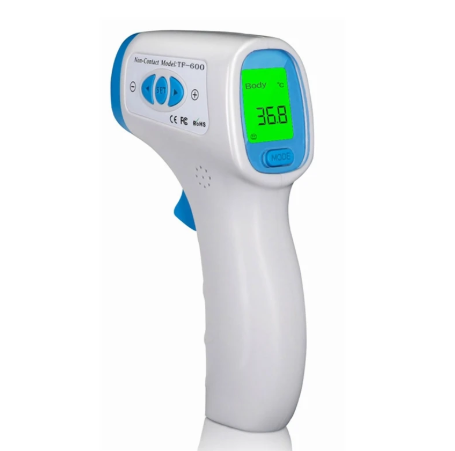Introduction to Non-Contact Thermometers
The evolution of medical technology has consistently aimed at making healthcare tools more efficient, accurate, and user-friendly. Among these innovations, the non-contact thermometer emerges as a game-changer, significantly improving the ease and hygiene of temperature measurement. These devices, which operate without direct contact with the skin, have become particularly indispensable in high-demand settings such as hospitals and during pandemics.
Non-contact thermometers offer several advantages over their traditional counterparts. Their ability to measure temperature without touching the subject's skin provides a safer and more sanitary option, especially beneficial in environments with a high risk of cross-contamination. Furthermore, their quick and precise readings enhance patient comfort and expedite healthcare operations.
How Non-Contact Thermometers Work
Non-contact thermometers primarily rely on infrared technology to measure temperature. They detect thermal radiation emitted by the body, which increases with temperature. This technology calculates temperature by measuring the infrared energy emitted and reflecting it in terms of temperature units.
● Infrared Technology Basics
Infrared thermometers consist of an optical system and a detector. The optical system gathers energy, which the detector then converts into an electrical signal. This signal is processed to give a temperature reading displayed digitally.
● Sensors and Measurement Process
The core component of a non-contact thermometer is its sensor, which captures infrared radiation. These sensors are sensitive to minute temperature differences, allowing for precise readings. The conversion from thermal radiation to temperature measurement occurs within seconds, making these thermometers highly efficient.
● Factors Influencing Accuracy
Several factors can influence the accuracy of non-contact thermometers: ambient temperature, distance from the subject, and environmental conditions such as airflow. Understanding and mitigating these factors is crucial for obtaining precise measurements.
Choosing the Right Non-Contact Thermometer
Selecting an appropriate non-contact thermometer involves considering several features and specifications to meet specific needs.
● Key Features to Consider
When selecting a thermometer, look for features such as measurement range, accuracy, response time, and ease of use. Additionally, features like a backlit display, memory recall, and automatic shut-off can enhance functionality.
● Brands and Models Comparison
The market offers a range of products, from Custom Non-Contact Thermometers to OEM and ODM Non-Contact Thermometers. Each option presents different advantages depending on the manufacturer, such as accuracy, durability, and additional features. It's vital to compare these aspects to find the best fit for personal or professional use.
● Budget and User-Friendliness
While high-end models may offer superior features, budget options can also deliver reliable performance. Evaluating the cost-to-benefit ratio will help in choosing a device that offers the best functionality within a reasonable price range. User-friendliness, particularly for non-professionals, is an important factor to consider.
Preparing to Take a Temperature Reading
Prior preparation is essential for ensuring accurate readings with non-contact thermometers.
● Importance of a Stable Environment
For precise measurements, it's critical to conduct readings in a stable environment. Rapid changes in ambient temperature can affect accuracy.
● Ensuring Cleanliness of the Device
Keeping the device free of dust and dirt will prevent potential disruptions in sensor performance. Regular cleaning as per the manufacturer's instructions can also prolong the device's longevity.
● Subject Positioning Guidelines
The position of the person being measured can significantly affect readings. Ensure the forehead is free from sweat or coverings, and the person remains still during measurement.
Step-by-Step Guide to Using the Thermometer
The method to accurately gauge temperature using a non-contact thermometer involves several steps.
● Correct Distance and Angle for Measurement
Maintaining the correct distance—usually a few centimeters—and the angle between the thermometer and the subject's forehead is crucial. This ensures the sensor captures the optimal amount of infrared radiation for an accurate reading.
● Calibrating the Device Before Use
Calibration ensures that the thermometer is providing accurate temperature readings. Follow the manufacturer's guidelines for calibrating the device regularly.
● General Troubleshooting Tips
If readings seem inconsistent, check if the device requires recalibration or if any obstructions are interfering with the sensor. Replacing batteries or resetting the device might also resolve issues.
Interpreting Temperature Readings Accurately
Understanding the implications of temperature readings is essential for assessing health conditions accurately.
● Understanding Normal Temperature Ranges
The typical human body temperature ranges from 97°F to 99°F (36.1°C to 37.2°C). A temperature above this range may indicate a fever, which requires attention.
● Recognizing Signs of Fever
Signs of a fever include sweats, chills, and an elevated temperature reading. Persistent high readings necessitate professional medical consultation.
● When to Consult a Healthcare Professional
If persistent high fever or other symptoms such as rash, severe headache, or breathing difficulties accompany a high temperature, it is crucial to seek medical advice.
Common Mistakes and How to Avoid Them
Avoiding errors is crucial for maintaining the reliability of non-contact thermometers.
● Avoiding Interference from External Factors
Temperature readings can be affected by external factors such as drafts or radiant heat sources. Ensure these are minimized during measurement.
● Mistakes in Handling and Care
Proper handling includes maintaining the device's integrity by avoiding drops and following maintenance guidelines to prevent damage to the sensitive components.
● Correct Usage Techniques
Accurate readings depend on correct usage techniques, as described above—understanding these techniques is fundamental to obtaining reliable data.
Benefits of Non-Contact Thermometers
These devices offer numerous benefits that make them indispensable in modern healthcare.
● Hygiene and Safety in Multiple Readings
Their non-contact nature minimizes the risk of cross-contamination, enhancing safety in environments requiring multiple readings.
● Convenience in High-Pressure Environments
Their quick response time and ease of use make them ideal for settings where time and precision are critical, such as emergency rooms and clinics.
● Use in Pediatrics and Sleep Monitoring
Non-contact thermometers are particularly useful in pediatrics and sleep monitoring because they reduce patient discomfort and disturbance.
Limitations and Considerations
While beneficial, non-contact thermometers have limitations that users should be aware of.
● Situations Where Accuracy Might Be Compromised
Extreme environments or improper usage can affect accuracy. Manufacturers typically provide guidelines to mitigate these effects.
● Comparing with Other Thermometer Types
It's essential to consider and compare the specific use case and requirements when deciding between non-contact and other types of thermometers, such as digital or mercury.
● Special Considerations for Different Age Groups
Accuracy can vary between age groups due to different skin characteristics. It's important to adjust usage techniques as necessary.
Future of Temperature Measurement Technology
As technology progresses, non-contact thermometers are expected to become even more advanced.
● Innovations in Non-Contact Thermometry
Future advancements may improve sensor sensitivity and reduce response time, extending the scope of use across various fields.
● Integration with Smart Devices
Integration with smart devices can allow users to track temperature over time more easily, providing valuable data to healthcare providers.
● Implications for Global Health Monitoring
As a tool for early fever detection, non-contact thermometers can play a critical role in global health monitoring and disease management.
Conclusion
In an age where personal and collective health security is paramount, the role of non-contact thermometers cannot be overstated. These devices provide accurate, quick, and hygienic readings, establishing them as vital tools in both personal and professional healthcare contexts. Whether sourced from a Non-Contact Thermometer manufacturer, Non-Contact Thermometer factory, or Non-Contact Thermometer supplier, these devices must be chosen with care to meet specific needs and ensure reliable performance.
● About Leis
Leis stands at the forefront of the medical device industry as a leading fast-growing supplier. With a focus on research and development, Leis offers a wide array of products including digital and infrared thermometers, pulse oximeters, and more. Committed to quality and innovation, Leis aims to establish long-term partnerships by providing high-quality products and exceptional service. Certified by CE and ISO13485, Leis ensures that all products meet stringent quality standards, supporting customers globally with OEM and ODM solutions.

